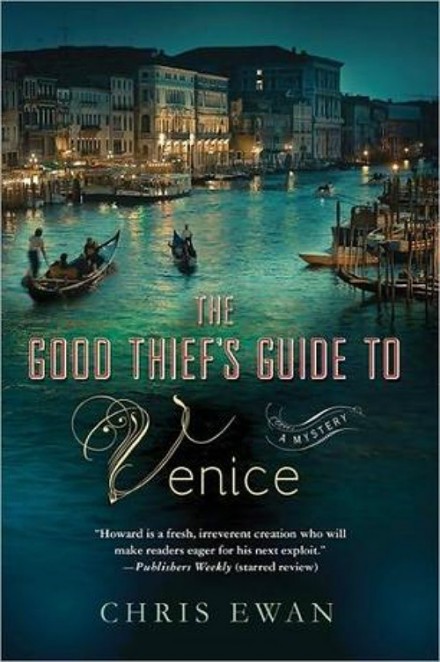The Good Thief’s Guide to Venice by Chris Ewan
When we reviewers want to show off, we tend to bandy words like “metafiction” around as if we actually know what they mean. I‘m not entirely sure such academic extravagance is justified but, in this case, it does give me the right starting point to talk about The Good Thief’s Guide to Venice by Chris Ewan (Minotaur Books, 2012). In many ways I’m always inclined to like books that self-consciously play with the medium of writing. Here we have a first-person narrative exploring the world of a semi-retired thief called Charlie Howard. As someone experienced in dishonest arts, this potentially makes him an unreliable narrator but, only in certain key moments does he actually hide things from the reader. For most of the book, he’s disarmingly honest and not a little confused by the circumstances in which he finds himself. That said, he’s abandoned the life of crime to focus on writing crime fiction. Appropriately, he’s created a burglar as hero who, in fiction, plays out some of the “real” crimes the author has committed. Should he ever be suspected as a very good thief, the police would only need to read his books to identify his methods and some of the crimes he had committed. Such are the minor excitements of an author when he choses to write about what he knows best. More importantly, it also gives Chris Ewan the chance to play with the craft of writing and, for example, discuss how to arrive at those sentences at the end of chapters intended to hook you into turning the page rapidly to find out what happens next.
This would all be wonderful if our author had stopped there. But he has also decided to engage in what’s intended as a slight aping of past prose styles. I would have been happy with a parody of hardboiled pulp. Having grown up surrounded by the detective magazines and adventure/mystery fiction that so dominated the first four decades of the last century, I enjoy an affectionate reprise if it’s done well. Nostalgia for days of innocent fun still runs strong. Unfortunately, instead of aiming high for Chandler or Hammett, we have something rather closer to a poor parody of Leslie Charteris filtered though Wodehouse. Now don’t get me wrong, the tradition of the gentleman as a thief is littered with interesting historical relics. The Saint is paper-thin plots but some morality, while Hornung’s Raffles shows slightly more brio. Perhaps the Maurice Leblanc creation Arsène Lupin is the best both in their originals and all those who followed in his footsteps. He does at least manage to avoid looking foolish. Chris Ewan has similar pretensions with his “good thief” taking on criminals who are at least as bad if not worse than he. That he emerges in one piece speaks loudly of some skill and quite a lot of luck, i.e. he does look foolish some of the time.
So where does all this leave us? I like the plot of this novel. There’s a certain elegance on display as we slowly work our way through the revelations to the punchline at the end. There are, however, a number of problems. I prefer to avoid coincidences and the arrival of one figure as we work our way up to the final confrontations is an egregious example of the phenomenon. It’s all a little too convenient in a story that had been moving along comfortably under its own steam. Secondly, there’s a serious problem in the tone of the book. Even at the best of times, it’s very difficult to generate humour out of a thriller scenario. In this instance, the reason for the failure is the metafictional self-consciousness of the first-person voice. When the author is smiling with us, showing us how clever he is in deconstructing the process of writing a page-turner, it’s difficult to make us laugh with or at the narrator when he falls flat on his face or goes through some other experience that might otherwise have raised a smile. This is easier with a third-person show-and-tell. A more omniscient author can expose the mechanism of the prat fall by walking us through the scene, giving us a sense of anticipation, and then laughing as the expected catastrophe befalls the character. In the first-person form, the main feeling is the embarrassment or humiliation of the victim.
Finally we come to the problem of a book wanting to be a caper movie. Although my heart will always belong to Rififi, we’ve all sat through and enjoyed The Italian Job, the Ocean’s series and all the others where the pleasingly criminal show off their skills with a sly but endearing smile. Sadly, this hero could not be played by George Clooney. Worse, the wit and humour, such as it is, comes over as rather more laboured. Earlier in the review, I referred to Wodehouse and the humour of this book has a certain period charm about it, i.e. it is populated by slightly eccentric characters with curious interests and superstitions (our hero feels he can’t write unless he can look up at the first edition of The Maltese Falcon he stole early in his career) with two strong female characters to help and hinder. But the version presented here is too long, the slight jokiness wears thin, and the payoff is not really amusing. It just feels like a reasonably good place to stop. So, on balance, The Good Thief’s Guide to Venice would have been better if a strong-willed editor had persuaded the author to cut out the deadwood and leave us with a faster-paced thriller where we might actually feel our hero was in real danger.
For a review of the next book in the series, see The Good Thief’s Guide to Berlin
A copy of this book was sent to me for review.
Recent Posts
- The Murder in Kairotei or Kairoutei Satsujin Jiken or 回廊亭殺人事件 (2011)
- A Billion Ways to Die by Chris Knopf
- Broken or The Hovering Blade or Banghwanghaneun Kalnal or 방황하는 칼날 (2014)
- Disclosures by Bill James
- Godzilla: Final Wars or ゴジラ ファイナルウォーズ (2004)
- Stalked: The Boy Who Said No by Patti Sheehy
- Innocence by Dean Koontz
- The Scarlet Tides by David Hair
- Death on Blackheath by Anne Perry
- Elective Procedures by Merry Jones
Categories
Archives
- December 2014
- November 2014
- October 2014
- September 2014
- August 2014
- July 2014
- June 2014
- May 2014
- April 2014
- March 2014
- February 2014
- January 2014
- December 2013
- November 2013
- October 2013
- September 2013
- August 2013
- July 2013
- June 2013
- May 2013
- April 2013
- March 2013
- February 2013
- January 2013
- December 2012
- November 2012
- October 2012
- September 2012
- August 2012
- July 2012
- June 2012
- May 2012
- April 2012
- March 2012
- February 2012
- January 2012
- December 2011
- November 2011
- October 2011
- September 2011
- August 2011
- July 2011
- June 2011
- May 2011
- April 2011
- March 2011
- February 2011
- January 2011
- December 2010
- November 2010
- October 2010
- September 2010
- August 2010
- July 2010
- June 2010
- May 2010
- April 2010
- March 2010
- January 2010
- September 2009
- August 2009
- July 2009
- June 2009

